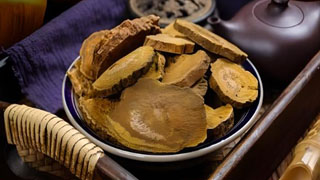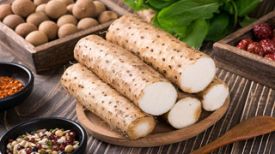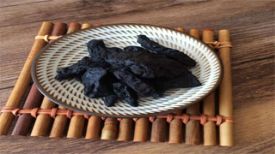
1. Aliases
General, Southern Rhubarb.2. Plant morphology
Perennial tall herbaceous plants. The rhizome and roots are thick and yellow brown in color. The stem is sparsely covered with short pubescence, and the nodes are dense and hollow. Basal leaves have fleshy and robust long stalks, about the same length as the leaves. The leaves are round or oval in shape, palmately lobed, with lobes in the shape of large teeth or wide triangles. The base is slightly heart-shaped, with small papillae near the veins above and pubescence below; Stem leaves are smaller, alternate, with short stalks; Stipules sheath like, membranous, densely pubescent.
Panicle terminal; The flowers are small, and the perianth is yellow white; Pedicels slender, with joints in the middle and lower parts; Perianth segments 6, 2 whorls, inner whorl slightly larger, elliptical; 9 stamens; Style 3, stigma head shaped. Achenes have 3 edges, wings grow along the edges, the top is slightly concave, and the base is slightly heart-shaped, red. The flowering period is from June to July, and the fruiting period is from July to August.
3. Origin distribution
Born on mountain forest edges or grassy slopes, wild or cultivated. Distributed in Sichuan, Yunnan, Guizhou, Hubei and other places.
4. Harvesting and processing
Harvest before withering of stems and leaves at the end of autumn or sprouting in the following spring, remove fine roots, scrape off the outer skin, cut petals or segments, and thread them into strings to dry or directly dry.
5. Characteristics of medicinal herbs
It is cylindrical, conical, oval or irregular block shaped, with a length of 3-17 centimeters and a diameter of 3-10 centimeters. Except for those who have a clean outer skin, the surface is yellow brown to reddish brown, and some may have a white like network texture. The remaining outer skin is brown, with many rope holes and coarse wrinkles.
Solid in texture, some centers are slightly soft, and the cross-section is light reddish brown or yellowish brown, showing graininess; The root and stem have a broad medullary area, with scattered or scattered star like dots; The root and wood are well-developed, with radial textures, and the formation layer is obvious without any star spots. The breath is fragrant, the taste is bitter and slightly astringent, and it feels sticky to the teeth when chewed, with a feeling of sand particles.
6. Nature, taste, and meridian tropism
Cold in nature and bitter in taste. Guipi Meridian, Stomach Meridian, Large Intestine Meridian, Liver Meridian, and Pericardium Meridian.
7. Effect and function
Relieve heat and defecate, cool blood and detoxify, remove blood stasis and clear meridians. Offensive drugs belonging to the subcategory of laxatives.
8. Clinical applications
Dosage of 3-30 grams, decoct and take. Used to treat solid heat constipation, stagnant abdominal pain, diarrhea and discomfort, damp heat jaundice, blood heat vomiting and bleeding, red eyes, pharyngeal swelling, intestinal carbuncle and furuncle, blood stasis and amenorrhea, and injuries caused by falls and bruises. Apply an appropriate amount externally to treat water and fire burns, as well as upper gastrointestinal bleeding.
9. Pharmacological research
The laxative component is bound anthraquinone glycosides, and the antibacterial component is free anthraquinone. Rhubarb does not contain rhubarb glycosides and can be used as one of the criteria for identifying genuine and counterfeit products.
Animal experiments have shown that the extract has laxative, antibacterial, hemostatic, promoting bile secretion, lipid-lowering, hypotensive, and anti-tumor effects. It also has effects on the digestive system, such as catharsis, cholestasis, liver protection, anti gastric and duodenal ulcers, and excitation of intestinal smooth muscle.
10. Chemical composition
This product mainly contains ingredients such as aloe emodin, emodin, emodin methyl ether, rhein, and emodin.
11. Taboos for use
Any symptoms that have not been resolved, such as blood deficiency and weak qi, spleen and stomach deficiency and cold, no excess heat, stagnation, or stasis, as well as before and after pregnancy, should be taken with caution. Taking raw rhubarb orally may cause side effects such as nausea, vomiting, and abdominal pain, which can generally be relieved after stopping the medication.
12. Compatibility prescription
① Treat edema and facilitate urination: divide rhubarb, Atractylodes macrocephala, and Fangji into equal parts. For the end, the honey pill is as big as the wutong. Drink ten pills of rice. A small convenience is worth it, I don't know how to increase it. (Da Huang Wan in Pu Ji Fang)
② Treatment of heat, carbuncle, and toxin: 45g of rhubarb, 30g of baiji, and 60g of puerarin. Above is the end, well water is mixed and applied, and when dry, it moistens. (The Complete Book of Jingyue: Da Huang Da Du San)
③ Difficulty in treating feces: 150g of rhubarb (filed, stir fried) and 60g of hemp seeds (ground). Above is the end. The honey pill wutong is big. Take ten pills each and cook them underwater after eating. (Da Huang Wan in "Ji Fang")
④ Treating typhoid fever for seven or eight days, the body is as yellow as an orange, with difficulty urinating, and the abdomen is slightly full: 180g of Artemisia annua, 14 pieces of gardenia (broken), and 90g of rhubarb (peeled). On the top three flavors, take a bucket of water and two liters. First, boil the wormwood and reduce it by six liters. On the inside two flavors, boil three liters and remove any residue. Divide into three servings, urinate quickly, and urinate like soap pod juice, with a bright red color. One night's belly is reduced. Huang has been urinating since childhood. (Yin Chen Hao Tang from "Treatise on Cold Damage")
The content of the article is for clinical reference only. Non professionals in traditional Chinese medicine are not allowed to try medication.


